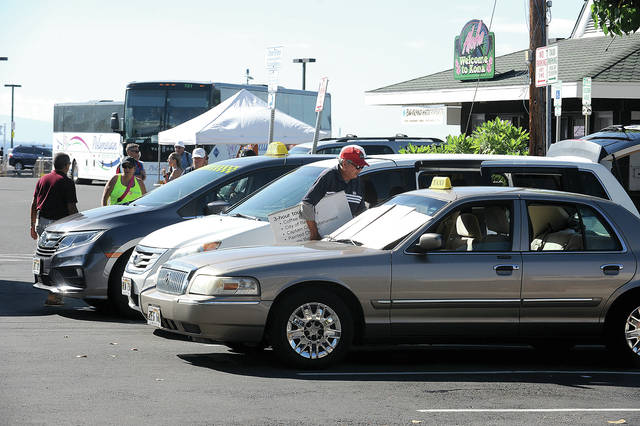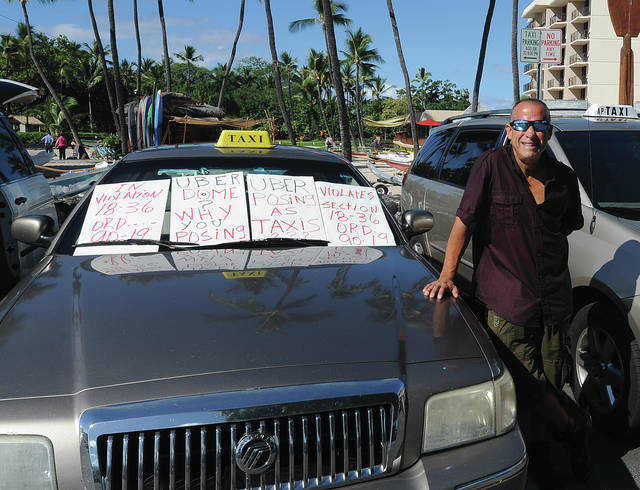KAILUA-KONA — Ian Work’s phone rang mid-interview.
He took the call while Kelly Williams, with whom he owns World’s Coolest Cab, spoke about the drop in cross-town rides they’ve experienced since Uber and Lyft entered the market 20 months ago. Work came back about 90 seconds later and apologized.
“As much as I’d like to just ignore this stuff, I can’t turn down — there’s another $40 there,” he said.
“Perfect,” Williams said to Work, “thank you.”
These days, many taxicab companies have to take the hails they can get. Ever since Uber and Lyft came into the local market in March 2017, some Hawaii Island taxicab drivers say they’re being put at an unfair disadvantage.
It’s an issue communities have faced throughout the country as ridesharing has upended traditional transportation companies, and between a local fare schedule that hasn’t changed in a decade and a lack of regulations specifically aimed at Uber and Lyft (which are considered transportation network companies and not taxi companies), long-time taxicab drivers are feeling the pressure.
“Our county is not benefiting from this in the least,” said Williams. “ … there will be a significant amount of drivers who don’t have anything else to fall back on, and those drivers, once they’re put out of business will be on public assistance.
Defining rides by rules
Transportation network companies are regulated under Hawaii’s insurance code, which sets insurance requirements for transportation network companies and drivers, as well as any local ordinances specifically regulating transportation network companies.
But the phrase “transportation network company” doesn’t appear once in the Hawaii County Code’s chapter on public transportation, the chapter that regulates taxicabs, school buses and the public transit system.
That’s in contrast to the revised ordinances of Honolulu, which explicitly defines the term and sets a number of standards for operators, including limiting passengers to the number of seat belts in the vehicle and restricting drivers from smoking in their vehicle with passengers inside.
It’s a situation that has some taxicab drivers feeling like they’re being run out of business by competitors who on the one hand aren’t subject to the upfront investment and annual fees taxicab drivers face and on the other aren’t restricted to the fixed fare rates that haven’t changed in a decade.
“It’s unfair. They’re not held to the same set of rules that we are,” said Work. “In fact, they’re held to no rules.”
Details of the dispute
Examples are plenty of the rules rideshares are breaking, said taxicab operators. Examples abound, too, of rideshares not having to follow the same requirements as taxis, which they say gives their competition an unfair advantage.
Victor Quiros, owner of A1 Taxi, pointed to the use of dome lights by some Uber and Lyft drivers, pointing to a county statute that prohibits anybody without a valid taxicab license from displaying “any sign, light or other device that identifies such motor vehicle as a taxicab.”
He also said drivers are reaping the benefits that should be reserved for taxis by picking up rides that weren’t prearranged or picking up roadside hails.
That’s not allowed in the rideshare model of operation.
A spokesperson for Lyft said the Lyft Amp, which sits on the dashboard (not the roof) “is the only sanctioned communication device that Lyft offers to drivers and any other light or device is not encouraged for use by Lyft.”
She also said riders looking to take a Lyft can’t hail rides and drivers are prohibited from accepting street hails.
Uber neither responded nor acknowledged questions sent to their press inbox.
Jared Keanaaina, who drove for Uber for a couple months last year, said it’s not uncommon, though, for drivers to give rides to passengers outside of the platform.
“Every Uber driver I knew, which was about six or seven of them, would do it outside,” he said.
He said it was often initiated by passengers who would ask if they could request their driver for a future ride. Because the app doesn’t allow users to request a specific driver, drivers would give passengers their phone number for future rides.
That was also helpful for passengers who would need return rides back from places where there might not be many drivers in the area.
But taxicab drivers also said Lyft and Uber vehicles are using parking stalls on Alii Drive that are reserved exclusively for taxicabs during part of the day even though taxi owners pay annually for a taxicab license that permits use of the stalls.
“We pay the Mass Transit — each one is $120. Times 100 taxis, that’s $12,000 we pay for these stalls,” Quiros said. “They’re paying zero dollars.”
Williams and Work also argued that taking a taxicab supports a local business versus Lyft and Uber, which are both headquartered in San Francisco.
“I’ve been here 14 years, I knew after a year or two, I could understand why it was important that you spend money locally, that you invest in your local economy,” Work said. “We’re kind of all in this together. We’re out here way away from everything else, we’ve kind of got to make things work on our own.”
Burdensome taxi startup costs?
Even starting with a car in “pristine condition,” Williams said, a taxicab operator is looking at hundreds of dollars in startup costs for the meter, top light and lettering. Considering the cost of a used vehicle and work needed to get it into good condition, she said, an operator can expect to pay $10,000.
Taxicab owners and drivers also have to navigate a series of paperwork, applications and a public hearing before they can even accept their first passenger.
In addition to the equipment requirements like installing and calibrating a meter, each vehicle requires a thorough inspection and a certificate from the Hawaii County Transportation Commission, which can only be granted after a public hearing determining that “public convenience and necessity” require the operation of a taxi. Taxicab owners can then get a license for the vehicle, which must be renewed annually at a cost of $120.
Even to operate a taxi, a driver needs to submit a 10-year background check from the courthouse, a seven-year driver’s abstract and a doctor’s clearance and also must pass a test assessing their ability to navigate the area and knowledge of taxi regulations. Then, Williams said, the driver pays $10 for their own personal license.
Taxicab drivers are also bound to charging rates fixed in statute: $3 for the start of a ride and first eighth of a mile or minute of waiting/elapsed time and 40 cents for each additional eighth of a mile and additional minute of waiting or elapsed time. Taxicab drivers may also charge $1 a piece for most types of baggage.
Those fees were set in 2008, when the county council last raised rates. And despite the county council also adding language to allow for an annual review of fares to determine whether they should be raised or lowered, that too has never happened.
Uber and Lyft drivers meanwhile aren’t subject to charging those fixed rates.
“Why do I have to always charge the same amount?” asked Work. “If I charge a different amount it’s either fraud or tax evasion depending on which way I go, but they can change their rate whenever they want.”
County looking at options
Hawaii County Mayor Harry Kim said he’s heard some of taxicab drivers’ concerns and said he spoke to Uber representatives when they were first trying to enter the local market. He said he originally sensed “a little bit of unfairness” to taxi companies given the heavy regulations they face that companies like Uber and Lyft aren’t subject to.
“So I told them I’m sure that’s going to bring on problems,” he said.
Kim said a staff member in his office is looking at how Oahu has approached the issue to determine where Hawaii County can find a blueprint.
“It’s the same thing I did in regards to vacation rentals,” he said. “We checked Maui, Kauai and Oahu and steal the best from all of them and learn from the best of all of them and make our own. It took us a long time to get here, but we’re getting there, and likewise with Uber, we’ll learn from others.”
Honolulu Mayor Kirk Caldwell in June vetoed a bill that would have capped surge pricing by Uber and Lyft, according to a Honolulu Star-Advertiser report at the time. An alternative from the mayor proposed reducing regulations on traditional taxis so they could run similarly to Uber and Lyft drivers.
A separate bill, introduced by Honolulu Councilman Trevor Ozawa, would require all private transportation companies that set a total fare disclose the amount to passengers before confirming the ride, the Honolulu newspaper reported.
As this county looks at the options, Kim said it’s unlikely there will be a one set of rules applying uniformly to taxicab drivers and Uber/Lyft drivers.
“It is not going to be by the same rules, because otherwise they will be just another taxi business,” he said. “And I just want to make sure it’s as fair as possible.”





